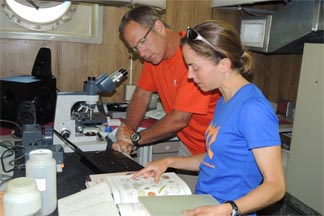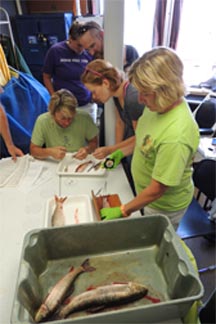Great Lakes science discoveries made with teachers aboard the R/V Lake Guardian exploring Lake Huron
A weeklong scientific research expedition with fourteen educators to study the waters and life of Lake Huron leads to scientific discoveries and amazing educational opportunities - Part 2 of 3.
Starting their science and learning journey in Alpena, Michigan, teachers first met with researchers from the Michigan
DNR Alpena Fisheries Research Station, where they were introduced to Lake Huron through the eyes of the Lake Huron fishery. Beginning with the recently revised
edition of The Life of the Lakes: A Guide to the Great Lakes Fisher y, teachers
learned about the ecological, cultural, and economic values of our Great Lakes fisheries. These valuable fisheries rely on healthy ecosystems, yet in recent
years, Lake Huron’s fisheries have been drastically disturbed by food web changes caused largely by introduction of aquatic invasive species. Teachers,
alongside Great Lakes scientists, boarded the U. S. EPA’s 180-foot R/V Lake Guardian to explore!
y, teachers
learned about the ecological, cultural, and economic values of our Great Lakes fisheries. These valuable fisheries rely on healthy ecosystems, yet in recent
years, Lake Huron’s fisheries have been drastically disturbed by food web changes caused largely by introduction of aquatic invasive species. Teachers,
alongside Great Lakes scientists, boarded the U. S. EPA’s 180-foot R/V Lake Guardian to explore!
Led by Eric Osantowski, U.S. EPA chemist, and Dr. Dave Jude and Erin Burkett, University of Michigan School of Natural Resources and Environment
researchers, teachers worked beside Great Lakes scientists to conduct research at various Lake Huron sampling stations. More than a science expedition,
educators sought to connect their research with educational opportunities for their students back in school. Based on a foundation of the Great Lakes Literacy Principles, Michigan Sea Grant Extension Educator,
Brandon  Schroeder and Great
Lakes Sea Grant Network educators, Kristin TePas and Jim Lubner led educators in exploring curriculum, educational resources, ideas and opportunities to
convert their research experiences into educational lessons.
Schroeder and Great
Lakes Sea Grant Network educators, Kristin TePas and Jim Lubner led educators in exploring curriculum, educational resources, ideas and opportunities to
convert their research experiences into educational lessons.
Science Discoveries are made! While on the R/V Lake Guardian, educators explored the Lake Huron ecosystem from top to bottom. By the end of the week, teachers found and documented several of the aquatic invaders affecting Lake Huron that they had learned about, including round gobies, quagga mussels, and spiny water fleas. Educators also studied physical and chemical parameters in describing water quality at various depths at each sampling station, including water clarity, water temperature, and dissolved oxygen. Sampling demonstrated that some of these factors differ noticeably between warmer upper layers of the Lake (epilimnion) from colder and deeper bottom layers of the Lake (hypolimnion) – these layers separated by a thermocline (metalimnion). Perhaps the greatest findings were in exploring the diverse web of life found living in the different habitats of Lake Huron from the smallest plankton (microscopic plants and animals) to the prey fish (smaller fish) and on to top predators, such as walleyes. Different organisms were found living in the bottom sediments (the benthic zone) than those found free floating or swimming in the open upper waters (the pelagic zone); and the productivity of lake and species found also differed between near-to-shore shallower waters than the more offshore sampling stations. Teachers even noted that water samples from Saginaw Bay water were more “green” with phytoplankton (plants) life when compared with offshore water samples.
What did the educators think of their experience? Visit the teachers’ blog to read more about the teachers’ experience and perspectives about life aboard a Great Lakes research vessel and scientific research activities on Lake Huron. Visit the first installment of Lake Huron Shipboard and Shoreline Science Program series to learn more about the program, partners, and teachers.



 Print
Print Email
Email

